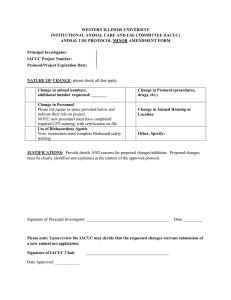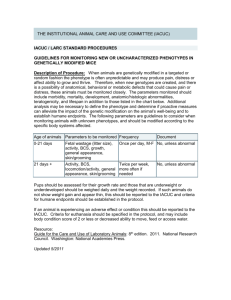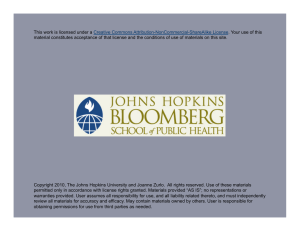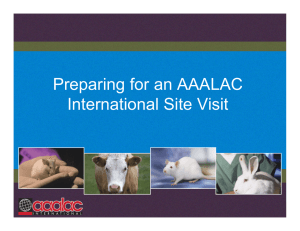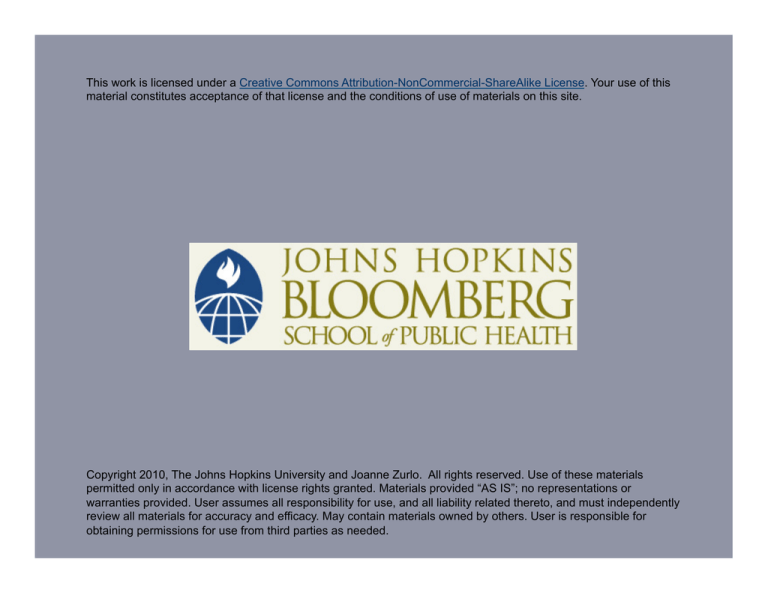
This work is licensed under a Creative Commons Attribution-NonCommercial-ShareAlike License. Your use of this
material constitutes acceptance of that license and the conditions of use of materials on this site.
Copyright 2010, The Johns Hopkins University and Joanne Zurlo. All rights reserved. Use of these materials
permitted only in accordance with license rights granted. Materials provided “AS IS”; no representations or
warranties provided. User assumes all responsibility for use, and all liability related thereto, and must independently
review all materials for accuracy and efficacy. May contain materials owned by others. User is responsible for
obtaining permissions for use from third parties as needed.
Institutional Animal Care and Use Committees:
An Overview
Joanne Zurlo, PhD
Institute for Laboratory Animal Research
National Academy of Sciences
Introduction to Joanne Zurlo, PhD
Paul A. Locke, DrPH, MPH, JD
Johns Hopkins University
Section A
Introduction and Considerations
U.S. Animal Protection Legislation
1966 Laboratory Animal Welfare Act (LAWA)—focused on dealers to
prevent pet theft (included dogs, cats, nonhuman primates, guinea
pigs, and rabbits)
1970 amendment to LAWA—expanded to include all warm-blooded
animals used in research (except farm animals)
1971—USDA excluded rats, mice, and birds from LAWA
5
U.S. Animal Protection Legislation
Animal Welfare Act (1985)—amendment of LAWA
- Created institutional animal care and use committees (IACUCs)
- Mandated minimization of pain and distress
- Specified exercise requirements for dogs
- Established guidelines to maintain psychological well-being of
nonhuman primates
6
Public Health Service Policy
Public health service policy on humane care and use of laboratory
animals
- Based on the Public Health Service Extension Act of 1985
- Applies to all institutions that receive funding from the Public
Health Service
- Is administered through the Office of Laboratory Animal Welfare
at the NIH with whom the institution files an “assurance” of
compliance with the policy
7
Public Health Service Policy
Public health service policy on humane care and use of laboratory
animals
- Protects ALL vertebrate animals
- Institutions must comply with guidelines set forth in the Guide
for the Care and Use of Laboratory Animals (NRC)
- Each assured facility must have an IACUC and report whether
they are accredited by AAALAC International
8
AAALAC International
Association for Assessment and Accreditation of Laboratory Animal
Care International (AAALAC International)
- Voluntary accreditation for laboratory animal care programs
(www.aaalac.org)
- Uses the Guide for the Care and Use of Laboratory Animals (the
Guide) as the basis for accreditation (along with other
reference documents)
- Conducts announced site visits every three years
9
IACUCs (PHS Policy)
Must consist of at least five members and include …
- A veterinarian with experience in laboratory animal science
- One practicing scientist with experience in animal research
- One member whose primary concerns are nonscientific (e.g.,
lawyer, clergy, ethicist)
- One member unaffiliated with the institution
10
IACUC Functions
Review the institution’s program every six months (using the Guide)
Inspect all the institution’s animal facilities every six months
(including satellite facilities)
Prepare reports of the evaluations and submit to the institutional
official (IO)
Review concerns involving care of animals at the institution
Make recommendations to the IO regarding any aspect of the
program, facilities, or training
11
IACUC Functions
Review and approve, require modifications in, or withhold approval
of PHS-conducted or supported activities related to the care and use
of animals
Review and approve proposed significant changes regarding the use
of animals in ongoing activities
Be authorized to suspend an activity involving animals
12
Program Evaluations
IACUC membership, functions, and procedures, including protocol
review
Facility inspection process
Provisions for reviewing and investigating concerns regarding animal
care and use
Record keeping practices
Methods for reporting
Occupational health and safety program
Veterinary medical care program
Personnel qualifications and training
Security and disaster preparedness
13
Facility Review
Satellite facilities (where animals are housed for more than 24
hours)
Areas where surgeries are done
Animal study areas (where USDA-covered species are held for more
than 12 hours)
Holding facilities
14
Facility Review—Categories
Sanitation
Food and water provisions
Animal identification
Waste disposal
Animal health records
Controlled and/or expired drugs
Environmental control
OHS
Staff training
Knowledge of rules/regulations
Security
15
Role of the Veterinarian
Oversight—serve on IACUC
Advisor—appropriate use of animals in research and testing
Animal health
- Disease detection and surveillance, prevention, diagnosis,
treatment, and resolution
- Handling and restraint; anesthetics, analgesics, and tranquilizer
drugs, methods of euthanasia
- Surgical and post-surgical care
- Animal well-being
- Oversight of medical records
16
Role of the Veterinarian
Training of institutional staff in care and use of animals
Assist in occupational health and safety program
Monitoring for zoonotic diseases
Monitoring standards of hygiene among institutional staff
Advising on biological and chemical hazard control policies as they
apply to animal care and use
17
Personnel Training
Animal welfare laws, regulations, policies, etc.
How to report deficiencies in animal care and use
Recognizing pain and distress
Alleviating pain and distress
PI responsibilities
Protocol requirements
Role of the IACUC
Behavior and appearance of healthy animals
Humane techniques for animal procedures
OHS issues, etc.
18
Proposal Review
New proposals
- Approved
- Modifications needed
- Approval withheld
- Proposal tabled or deferred
19
Proposal Review
Changes to approved protocols
- Study objectives
- Nonsurvival
survival surgery
- Degree of invasiveness
- Species or number of animals
- Personnel involved in animal procedures
- Anesthetic agents or use of them
- Method of euthanasia
- Duration, frequency, or number of procedures performed on an
animal
20
Proposal Review
Frequency of review of proposed protocols
- PHS policy requires review of protocol at least once every three
years
- AWRs require annual review (may be done in a report by the PI
to the IACUC verifying that activities were conducted according
to approved protocol)
21
The Three Rs
Any proposed activity involving animals should be reviewed using
the three Rs as guidelines
- Replacement
- Reduction
- Refinement
22
Replacement Considerations
Living systems, e.g., organ, tissue, or cell culture techniques,
invertebrate models, microorganisms, and, if necessary, less
sentient animal species
Nonliving systems
Computer models or simulations
23
Reduction Considerations
Rational selection of group size including pilot studies and power
analysis
Careful experimental design
Maximizing use of animals
Correct choice of model (consider inbred strains)
24
More Reduction Considerations
Use healthy animals (controlling infections)
Minimizing loss of animals (good post-op care, avoiding
unintentional breeding)
Appropriate statistical analysis
25
Refinement Considerations
Minimizing pain and distress—what the IACUC should look for in a
proposal
- Appropriate sedation and analgesia
- Criteria for timely intervention, removal of animals from study
or euthanasia
- Details of post-procedural care
26
More Refinement Considerations
Examples of procedures that may cause pain and/or distress
- Physical restraint
- Survival surgeries
- Food or water restriction
- Death as an endpoint
- Noxious stimuli
- Skin or corneal irritancy testing
- Tumor burdens
- Intracardiac or orbital sinus blood sampling
- Abnormal environmental conditions
27
Activities with Animals Must Also Include …
Written narrative description of methods and sources used to
consider alternatives to procedures that may cause pain and/or
distress
Written assurance that activities do not unnecessarily duplicate
previous experiments
28



